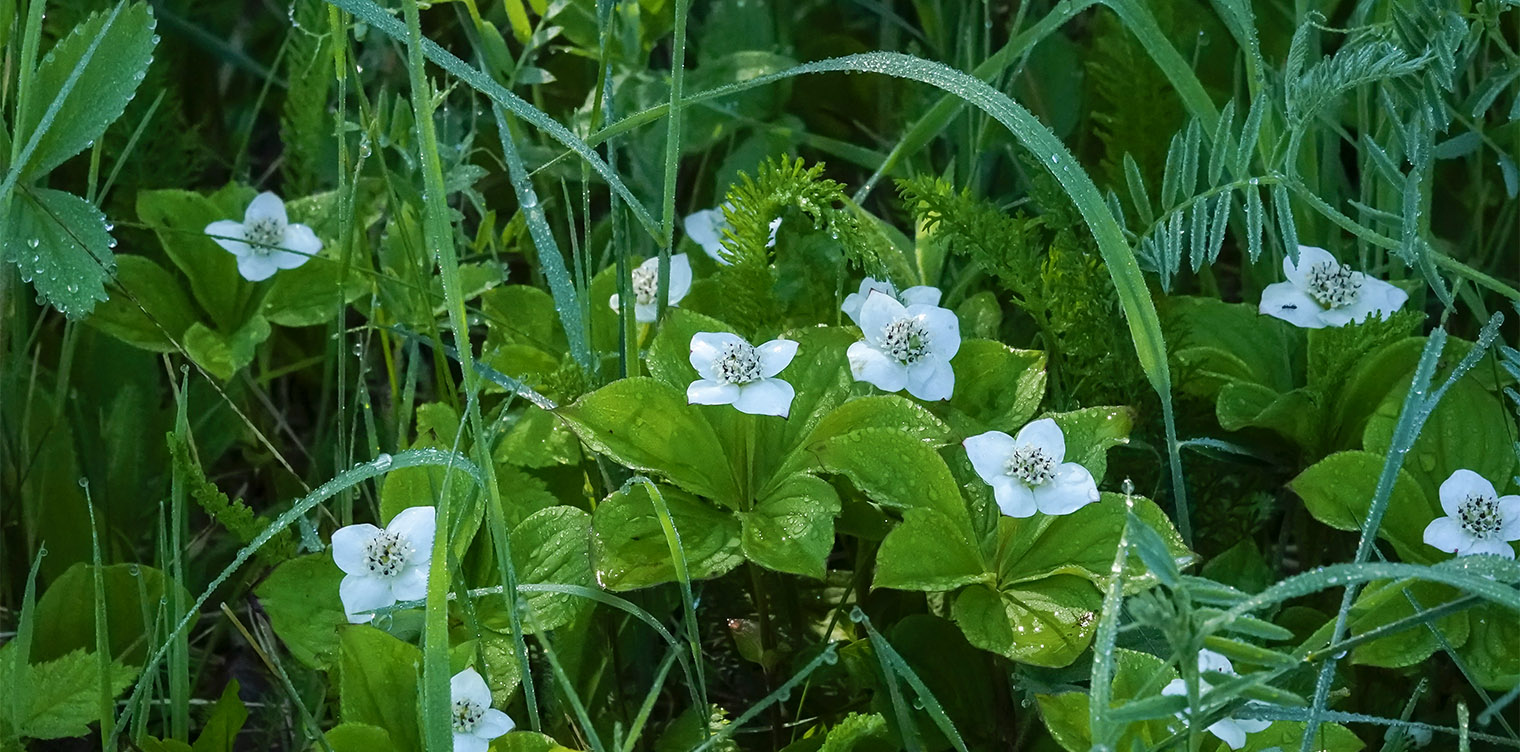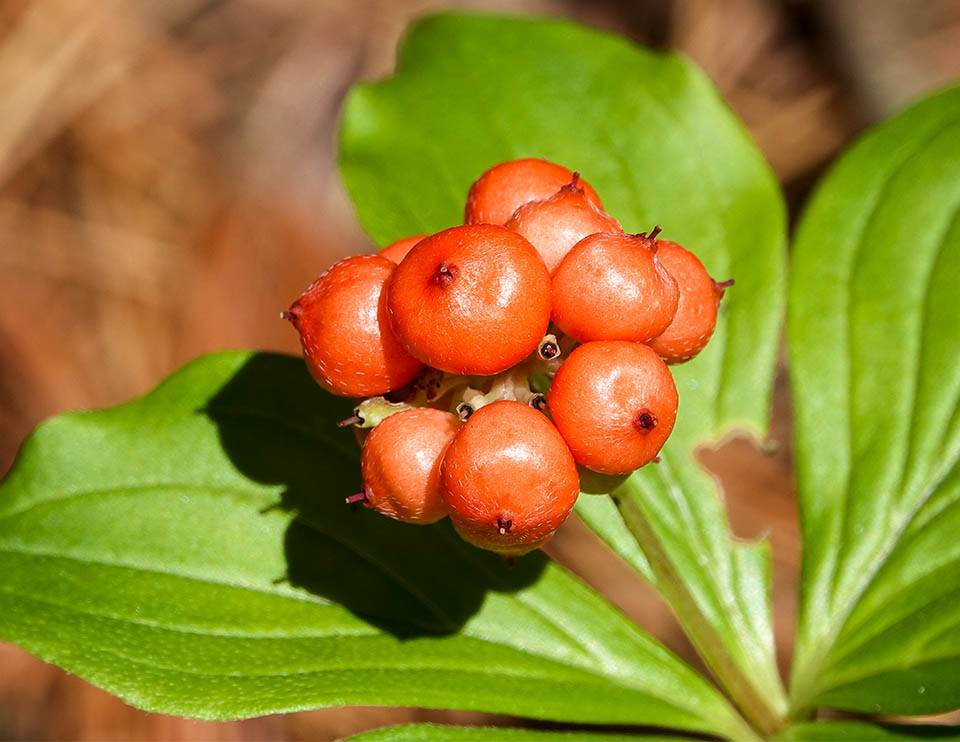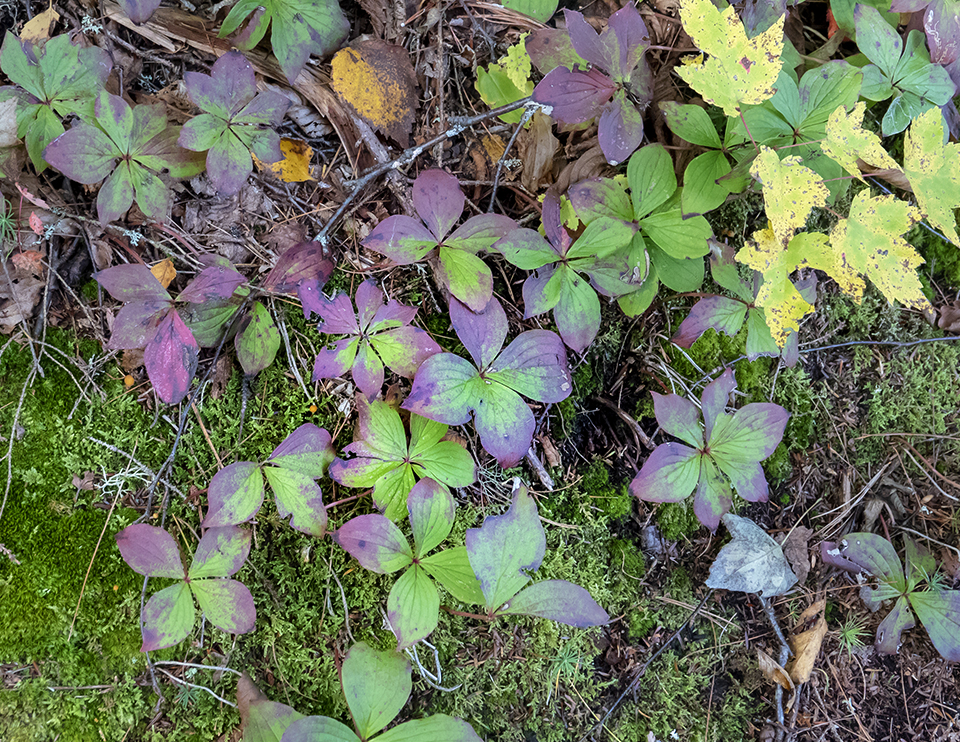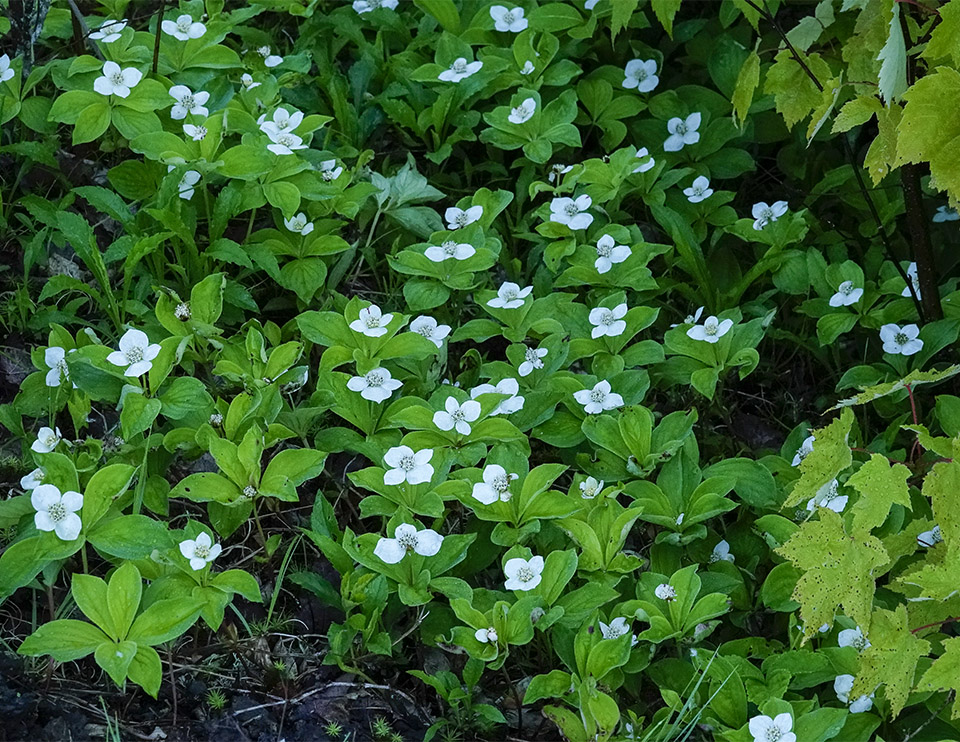Wildflowers of the Adirondacks:
Bunchberry (Cornus canadensis)

Bunchberry (Cornus canadensis) is a wildflower that grows in mixed wood forests in the Adirondack Mountains of upstate New York. Its dogwood-like white flowers appear in late spring, followed by bright red berries in summer.
This plant is also called Bunchberry Dogwood, Dwarf Dogwood, Canadian Bunchberry, Dogwood Bunchberry, Pudding Berry, Crackerberry, Creeping Dogwood, and Dwarf Cornel. The genus name cornus is Latin for horn – a reference to the hardness of the wood of some dogwoods. Most other members of the dogwood genus are trees or shrubs. Bunchberry is listed as threatened in Iowa and Ohio, and endangered in Illinois, Indiana, and Maryland.
Identification of Bunchberry

Bunchberry is an erect, low-growing plant, three to eight inches tall. It grows from creeping roots and often forms colonies.
Bunchberry leaves are dark green and shiny. They appear to grow in whorls of four to six.
- The leaves are 1.5 to 3 inches long, with smooth edges.
- The leaves are oval, pointed at both ends, and have prominent veins curving into an arc.
- In the fall, Bunchberry foliage contributes to the fall color, by turning a striking purple or wine-red.
Bunchberry plants sport what appears to be a single, showy white flower in late spring and early summer. The "flower" is actually a series of four large petal-like bracts, surrounding the actual flowers, which are tiny and greenish, with four minute petals. The flower head is usually about an inch wide. In the Adirondacks, Bunchberry usually begins flowering in late May or early June.
The flowers are followed by fruit, starting in mid-summer. The fruit consists of a cluster of bright red berries, about a quarter of an inch wide. Each of the red drupes contains one smooth seed. In the Adirondacks, look for the berries starting in late July through mid-August, depending on the weather. The fruit starts off green, gradually turning red.
Uses of Bunchberry

Bunchberry fruit is said to edible, but not very flavorful. The fruits reportedly can be consumed raw or cooked. Native Americans used them in puddings and sauces, ate them raw, or dried them for winter use. The fruit is said to be rich in pectin.
Bunchberry was used medicinally by a number of native American groups. For instance, the Abnaki used an infusion of the leaves as a cathartic tea. The Hoh used an infusion of the bark as a tonic. The Iroquois took a decoction of the whole plant for coughs and fevers.
Wildlife Value of Bunchberry
Bunchberry provides a food source for some species of wildlife. In some parts of its range, White-tailed Deer consume Bunchberry foliage, as do caribou, moose, and elk, although this plant does not appear to be a preferred food source for any of them. Bunchberry fruits are eaten by American Black Bears and small mammals. Eastern Chipmunks, American Martens, Eastern Cottontails, and Snowshoe Hares feed on bunchberry stems and fruits.
Bunchberry is also used by some song and game birds. The fruits are eaten by Veeries, Ruffed Grouse, Philadelphia Vireos, Warbling Vireos, and White-throated Sparrows.
Distribution of Bunchberry

Bunchberry's range extends throughout Canada, Alaska, and other northern US latitudes. In the continental US, it is limited mostly to mountainous regions
In New York State, Bunchberry grows in most counties in the eastern half of the state. This plant is very common in the northern and cooler parts of New York, becoming rare and scattered in the southern and warmer parts of the state. Bunchberry is found in all counties within the Adirondack Park Blue Line.
Habitat of Bunchberry
Bunchberry tolerates a wide range of soil types and moisture and nutrient conditions, mainly in climates that are cool and moist. It grows well in well-drained soils in full sun to partial shade, but can also grow in poorly drained soils and dense shade. The species tolerates a range of pH, but is most often found on slightly to very acidic sites.
With these rather flexible requirements, Bunchberry occurs in both coniferous and mixed forests, as well as some wetlands. This species generally persists after forest disturbances and can occur in all stages of forest succession. It appears to be more abundant in later successional stages. In the Adirondacks, Bunchberry is found in a wide variety of ecological communities:
You can find Bunchberry on virtually all the trails covered here. Look for Bunchberry in same areas that host Partridgeberry, Goldthread, and woodland ferns.
References
Michael Kudish. Adirondack Upland Flora: An Ecological Perspective (The Chauncy Press, 1992), pp. 23-28, 164.
New York Flora Association. New York Flora Atlas. Cornus canadensis L. Bunchberry. Retrieved 11 July 2019.
United States Department of Agriculture. The Plants Database. Bunchberry Dogwood. Cornus canadensis L. Retrieved 18 March 2017.
United States Department of Agriculture. Fire Effects Information System (FEIS). Species Reviews. Cornus canadensis. Retrieved 18 March 2017.
Flora of North America. Cornus canadensis Linnaeus. Retrieved 18 March 2017.
New York State. Department of Environmental Conservation. New York Natural Heritage Program. Ecological Communities of New York State. Second Edition (March 2014), pp. 72, 74, 74-75, 76, 92-93, 104-105, 106-107, 109-110, 121-122, 122, 122-123, 123, 123-124, 124. Retrieved 17 October 2015.
New York Natural Heritage Program. 2019. Online Conservation Guide for Alpine Krummholz. Retrieved 11 July 2019.
New York Natural Heritage Program. 2019. Online Conservation Guide for Balsam Flats. Retrieved 11 July 2019.
New York Natural Heritage Program. 2019. Online Conservation Guide for Black Spruce-Tamarack Bog. Retrieved 11 July 2019.
New York Natural Heritage Program. 2019. Online Conservation Guide for Ice Cave Talus Community. Retrieved 11 July 2019.
New York Natural Heritage Program. 2019. Online Conservation Guide for Mountain Fir Forest. Retrieved 11 July 2019.
New York Natural Heritage Program. 2019. Online Conservation Guide for Mountain Spruce-Fir Forest. Retrieved 11 July 2019.
New York Natural Heritage Program. 2019. Online Conservation Guide for Northern White Cedar Swamp. Retrieved 11 July 2019.
New York Natural Heritage Program. 2019. Online Conservation Guide for Open Alpine Community. Retrieved 11 July 2019.
New York Natural Heritage Program. 2019. Online Conservation Guide for Pine-Northern Hardwood Forest. Retrieved 11 July 2019.
New York Natural Heritage Program. 2019. Online Conservation Guide for Spruce Flats. Retrieved 11 July 2019.
New York Natural Heritage Program. 2019. Online Conservation Guide for Spruce-Fir Rocky Summit. Retrieved 11 July 2019.
New York Natural Heritage Program. 2019. Online Conservation Guide for Spruce-Fir Swamp. Retrieved 11 July 2019.
New York Natural Heritage Program. 2019. Online Conservation Guide for Spruce-Northern Hardwood Forest. Retrieved 11 July 2019.
New York State. Adirondack Park Agency. Preliminary List of Species Native Within the Adirondack Park Listed Alphabetically by Scientific Name and Sorted by Habit. Volume 1. Updated 10.23.2006. Retrieved 26 January 2017.
Anne McGrath. Wildflowers of the Adirondacks (EarthWords, 2000), p. 12, Plate 6.
Lawrence Newcomb. Newcomb's Wildflower Guide (Little Brown and Company, 1977), pp. 152-153.
Ruth Schottman. Trailside Notes. A Naturalist's Companion to Adirondack Plants (Adirondack Mountain Club, 1998), pp. 77-80.
National Audubon Society. Field Guide to North American Wildflowers. Eastern Region (Alfred A. Knopf, 2001), pp. 488-489, Plate 45.
William K. Chapman et al., Wildflowers of New York in Color (Syracuse University Press, 1998), pp. 6-7.
Alexander C. Martin, Herbert S. Zim, and Arnold L. Nelson. American Wildlife & Plants. A Guide to Wildlife Food Habits (New York: Dover Publications, 1951), p. 352.
John Eastman. The Book of Forest and Thicket: Trees, Shrubs, and Wildflowers of Eastern North America (Stackpole Books, 1992), pp. 44-45.
Plants for a Future. Cornus canadensis - L. Retrieved 18 March 2017.
Bradford Angier. Field Guide to Edible Wild Plants. Revised and Updated. (Stackpole Books, 2008), pp. 34-35.
University of Michigan. Native American Ethnobotany. A Database of Foods, Drugs, Dyes and Fibers of Native American Peoples, Derived from Plants. Cornus canadensis L. Bunchberry Dogwood. Retrieved 18 March 2017.
The Cornell Lab of Ornithology. Birds of North America. White-throated Sparrow and Yellow-bellied Flycatcher. Subscription web site. Retrieved 18 March 2017.
Nancy G. Slack and Allison W. Bell. Adirondack Alpine Summits: An Ecological Field Guide (Adirondack Mountain Club, Inc., 2006), p. 25.
Allen J. Coombes. Dictionary of Plant Names (Timber Press, 1994), pp. 47-48.
